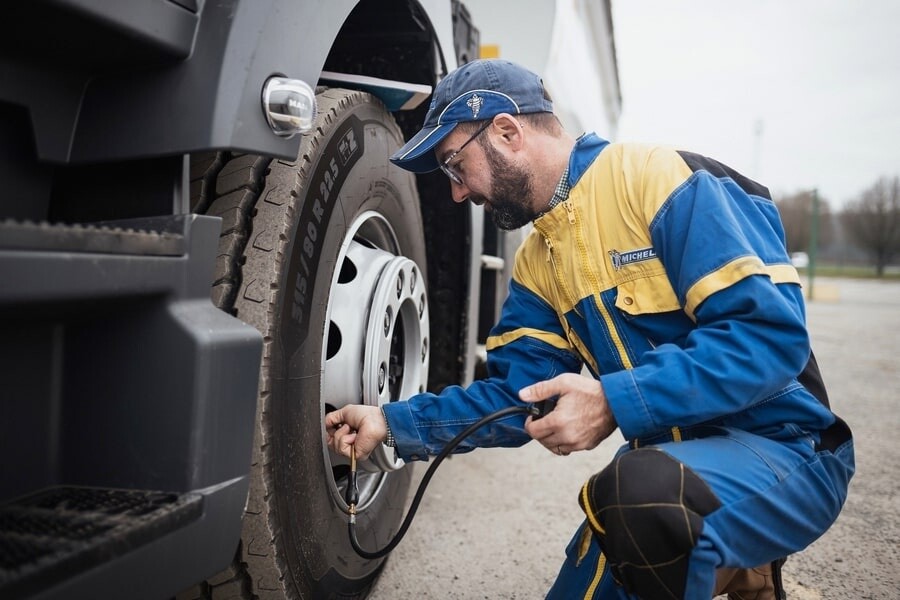
van tyre maintenance tips
7 Tyre Maintenance Tips for Van Operators: How to Optimise and Simplify Tyre Care
Published on 4 October 2024 - 3 minute(s) read
Tyre maintenance is an important factor when it comes to your fleet. It not only improves safety, reliability and the technical condition of your vans, but it can benefit your bottom line if managed in the right way.
Effective tyre maintenance is essential for van fleet operators in Australia. Proper tyre care boosts safety, reliability, and vehicle performance, and can have a significant impact on your operational costs.
Van fleet operators should monitor the condition of their van tyres regularly in order to protect their investment and to predict when they will need to maintain or replace them.
Van operators should regularly monitor tyre condition to safeguard their investment and ensure timely maintenance or replacement. Given the demanding conditions Australian van tyres often face—tight urban streets, rugged terrains, and frequent stop-and-go driving—proper maintenance is crucial. How can you extend the lifespan of your van tyres?
1. Choose the right tyre for your van
Choosing the correct tyres for your van is crucial for safety and performance. Ensure the tyres have the appropriate load capacity and dimensions to match your vehicle and comply with Australian regulations. This means the tyre must:
- Be capable of carrying the required load.
- Be fitted to the correct wheels in good condition.
- Be the right size for your vehicle.
Additionally, consider the following factors:
- Damage Resistance: Look for tyres with robust sidewall protection
- Whole life costs: evaluate the overall cost-effectiveness of the tyres.
- On-road performance: Prioritise tyres with effective tread patterns, all season performance, low rolling resistance, and good grip in both wet and dry conditions.

tip
Rolling resistance can impact your fuel consumption and wet grip.
This information is visible on the tyre label making it easier to choose wisely.
2. Monitor tyres regularly
Maximising uptime is a major challenge for fleets ౼ as downtime quickly translates into loss revenue. Busy drivers and owners tend to forego regular checks in favour of speedy deliveries.
However, taking the time to spot problems early on can yield substantial gains. For instance, a stone or nail lodged in your tyre, if left unchecked, can cause a loss of pressure, leading to a roadside breakdown or even an incident whilst driving. This could result in emergency repair costs, lost loads, or missed urgent delivery.
To avoid such issues, follow these steps:
- Use Manufacturer Recommended Inflation Pressures: Always use the inflation pressures prescribed by the van manufacturer for the loads you carry.
- Check Tyre Pressure Regularly: Use a high-quality pressure gauge to check tyre pressures when the tyres are cold, ensuring accuracy.
- Build a Baseline: Regular checks help you understand what is normal for your vehicle. If anything changes, you can spot it quickly and act before it becomes an emergency.
Spending just five minutes on these checks each day can save you time and money in the long run!

tip
Instead of checking tyres at the start of a day, have your drivers do a check at the end of their day౼ they’ll be less in a hurry and repairs can be done overnight, leaving the van ready to hit the road in the morning!

michelin mechanic checking tyre pressure
3. Keep a spare on hand
Many fleets today choose to forego carrying a spare tyre in the vehicle to maxmise payload capacity. If you’re struggling to decide whether to carry a spare, consider a middle ground to keep spare tyres at your depot. This strategy allows you to maximise payload while still having a backup available.
If you plan to store spares in the depot, follow these guidelines:
- Regular Pressure Checks: Check the pressures of stored tyres at least once a week, as tyres naturally lose pressure over time.
- Proper Storage Conditions: Store tyres in a clean, dry, and cool environment to prevent damage.
By maintaining spare tyres at your depot, you ensure that you have a backup ready without compromising your van’s payload capacity.

tip
If you choose to run without a spare, it is all the more important to keep up with regular vehicle checks!
4. Change your tyres the right way
Ideally, all four tyres should be changed at the same time. However as front and rear tyres wear at different rates, this may not always be possible.
New tyres should always be fit to the rear and worn rear tyres moved to the front ౼ this maintains vehicle stability and ensures that handling characteristics will be similar to those to which the driver is accustomed. It also keeps the average age of tyres on your vehicle lower and makes sure you get all the value out of the tyres before changing.
5. Perform Regular Wheel Balancing
Unbalanced wheels can accelerate tyre wear, damage shock absorbers and steering components, and cause vehicle vibrations that lead to driver fatigue.
Wheel balancing involves redistributing the weight around the tyre, which improves tyre life, vehicle performance, and safety. Balance your wheels at least once a year and whenever you buy or fit new tyres.
6. Rotate Your Tyres Regularly
Since vehicle weight is not evenly distributed, regular tyre rotation ensures even wear, enhancing performance, braking, and handling.
Refer to your vehicle’s owner’s manual for rotation recommendations. Generally, tyres should be rotated every 10,000 km. A good rule of thumb is to rotate tyres each time you change your oil.
7. Inspect for Punctures and Wear
Regularly inspect your tyres for sharp objects that could cause punctures, uneven wear patterns indicating pressure issues, and worn-down tread indicators. Address these issues promptly to prevent further damage and ensure safe driving conditions.
Maintaining your van tyres is crucial for ensuring safety, extending tyre life, and optimising vehicle performance. By selecting the right tyres, regularly checking pressure and condition, keeping spares, performing wheel balancing, rotating tyres, and inspecting for punctures and wear, you can reduce downtime and save costs. Implementing these tips will help you keep your fleet running smoothly and efficiently, enhancing overall operational success.
Explore Michelin’s range of van tyres to find the best options for your fleet.
FAQ
Maintaining good tyres involves regular checks and maintenance. Ensure that your tyres are properly inflated according to the manufacturer’s specifications, as incorrect pressure can lead to poor handling and increased wear. Rotate your tyres regularly to ensure even wear, and have them balanced and aligned as needed. Inspect tyres for visible damage, such as cuts or bulges, and check tread depth to ensure adequate traction. Regularly clean your tyres to remove debris that can cause damage.
The most important task in tyre maintenance is ensuring proper tyre inflation. Correctly inflated tyres improve vehicle handling, fuel efficiency, and extend the lifespan of the tyres. Under-inflated or over-inflated tyres can lead to uneven wear, decreased performance, and a higher risk of blowouts. Regularly check tyre pressure, especially before long trips, and adjust it according to the manufacturer’s recommended levels.

tip
When moving tyres from one axle to another, pressure should always be adjusted to suit the new positions.

gettyimages 930571046
car going fast on a road by night





